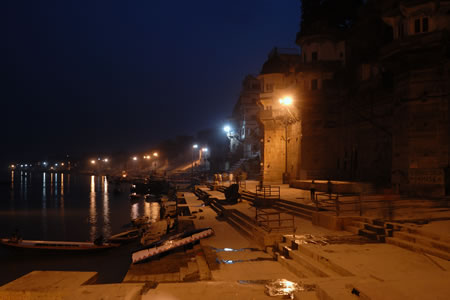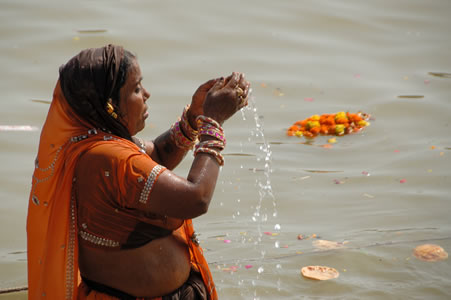English | Dutch |
|
| Varanasi, an incentive for every sense | |
Bodhgaya (India), November 22nd 2010 |
|
We looked forward to our visit to the city of Varanasi with mixed feelings. Varanasi is one of the holiest cities for Hindus and is mainly known for the millions of pilgrims that visit the city every year to take a bath in the holy Ganges River. Other people come to Varanasi to die and being cremated along the bank of the river to quicken their journey to heaven. Varanasi is also a city where travellers are put to the proof. There is an almost continuous attention of so-called touts who do everything to earn some rupees from them. These very irritation young males are pushing travellers to spend money at places (hotels, restaurants, rickshaw drivers, etc), where they get a commission. With sharpened knives we arrive at the bus station of Varanasi. We are completely prepared for touts that will jump on the bus to secure their prey. These guys want to ‘help’ us finding a rickshaws, rooms and other services from which they receive significant commissions. The main irritation is that these slick guys do not accept ‘no’ as an answer. But for some inexplicable reasons, there is not one tout on the bus station to meet us. We can get placidly from the bus to find two rickshaw drivers that can bring us to the old part of town where we want to find a hotel. The ride is great. The rickshaw drivers are steering their bikes through a bristling mass of bicycles, pedestrians, auto-rickshaws, a sporadic car and many other rickshaw drivers with a huge variety of cargo. There are also plenty of cows walking and laying on the street, quietly ruminating their meals, and who are absolutely not disturbed by the huge amounts of traffic that try to skirt around them. |
|
 |
|
A view on one of the ghats at night |
|
As most other cities in India that we visited so far, Varanasi is also a dirty city. There are no garbage cans which mean that most people throw their garbage on the streets. Sporadically, there are men with handcarts that remove the biggest piles of garbage. The streets are also dotted with smelly pies that fell out of the back of one of the many holy cows that stroll through the city. So, besides using your eyes to enjoy the beauty of Varanasi, you also need to keep your eyes on the street to avoid the cow manure. After a ride of half an hour on the rickshaw, we arrive in the old city. And because of the small alleys of the old city, we have to walk the last ten minutes to arrive at the area where many hostels are located. We decided to go to the area around Manikarnika Ghat, the most important cremation ghat of the city. A ‘ghat’ is a place at the bank of the Ganges River that people use to bath, do ceremonies or cremate their loved ones. We pay the rickshaw drivers and enter the maze of small alleys in search for a hostel. It doesn’t take long before a tout spots us. As always, the conversation starts in the same way. They ask where you are form and after you answered them, they always say something nice about your country. But soon after, he shows his real face and tries to take you to one of the commission paying hostels. A ‘no’ is not accepted and even when you turn them down, they start following you. If you enter a hostel of your own choice, they follow you inside and tell the reception in the Hindi-language that he brought you there. Of course, with the goal to collect a commission after you checked in. We decide to walk to Manikarnika Ghat first and split the group over there. Two people are staying at the backpacks, while the other two start looking for a hostel. The advantage of walking without big backpacks is that touts think that you have already checked in at a hotel. Eventually, after declining different touts, we find a small and friendly hostel with the name Sankatha Guesthouse. | |
 |
|
A pilgrims prays in the holy Ganges River |
|
| In the days after, we get to know Varanasi as a city with many faces. The chain of ghats at the bank of the Ganges River is the absolute highlight of the city. They are an incentive for every sense you have. Most ghats are used by pilgrims to take a holy bath, to wash away all lifetime sins. Men in short unflattering shorts and ladies in beautifully coloured sarees and shalwar kamiz dresses (traditional Indian dresses) plunge in the river that looks more like pea soup than water. The quality of the water seems to be extremely bad. It is a miracle that people ‘survive’ a bath in this water without becoming sick. Some people even soak their babies in it. But for a matter of fact, the pollution of the Ganges water is for 95% caused by the many cities on the banks of the river that dump unfiltered sewer waste on the river. Less than 5% is caused by the pilgrims. At the ghats it also swarms with so-called Sadhu’s (holy Hindu men) that earn some money with giving blessings to pilgrims and tourists. Many just married couples take the chance to buy a blessing from a Sadhu to give their marriage a head start. We witnessed also a marriage ceremony at one of the ghats. The couple, from the lowest caste, brought their family to one of the holiest places in the country, to fulfil all the ceremonies. We even saw them handing over the dowry, consisting of money, jewels and kitchen appliances, from the mother of the bride to the mother of the groom.
Also after dusk it is an experience to visit the ghats. The darkness in combination with the orange gas lamps that illuminated the ghats, and the mist that hovers over the Ganges River, gives the whole a very mystical atmosphere. At one of the most important ghats of the river, a daily ceremony is performed to honour the river and many pilgrims burn small candles on floating devices that are send on the river. The goal is always the same: increasing the karma. But the ghats do not only leave a positive impression. The less busy ghats are used by the poorest people of the city to spend the night, and men use these ghats massively to urinate. The smell is disgusting and the little streams of urine flow in the river often only a metre away from bathing pilgrims. Also the public cremations that take place at some of the ghats can be shocking for unprepared visitors. Bodies of dead people are carried on bamboo stretchers through the small alleys of the old town, on there way to the burning ghats. Traders around the ghats deal in wood that is used to cremate the bodies. There are also some photo shops that earn money by photographing the cremations. And to show off the quality of their services, nothing revealing photographs are displayed in the shop windows of their little businesses. After a cremation of three hours, all the remaining is thrown in the river. The poorest people of the city fish with big magnets in the waters in front of the cremation ghat, in search of valuables that are given with the deceased during the cremation (like jewellery). ‘The one’s death is the other man’s bread’ in the most visible form. And it all happens in public; visible for everybody who wants to see it. Varanasi is in every way an incentive for every sense you have. But be prepared; buckle yourself up for a ride you are never going to forget! | |